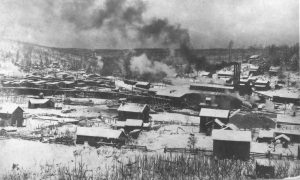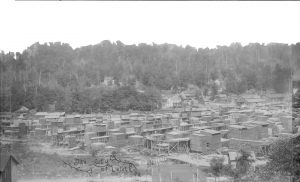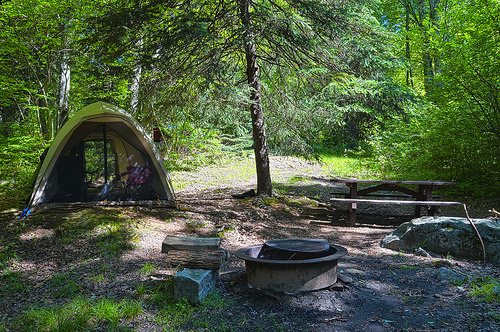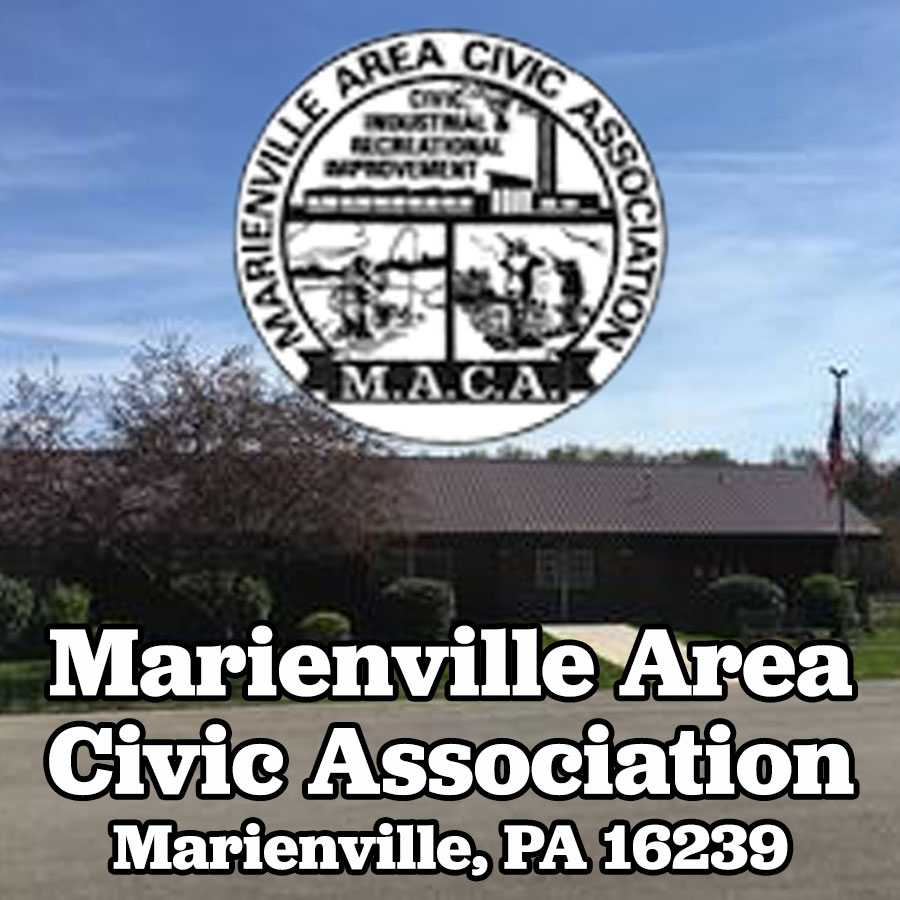Article and photos courtesy of Bob Imhoff
 This area has been recently nominated and accepted onto the National Register of Historic Places. The area was once a bustling logging town, established in 1889, with over 600 inhabitants. The town had a large sawmill, shingle mill, broom handle factory and a rail connection for shipping products to Sheffield, PA. Once the timber supply was exhausted in 1913, the mills shut down and the town was deserted.
This area has been recently nominated and accepted onto the National Register of Historic Places. The area was once a bustling logging town, established in 1889, with over 600 inhabitants. The town had a large sawmill, shingle mill, broom handle factory and a rail connection for shipping products to Sheffield, PA. Once the timber supply was exhausted in 1913, the mills shut down and the town was deserted.
The Federal Government purchased the site in 1925, adding it to the newly formed Allegheny National Forest (1923). In the 1930s, the Forest Service (using CCC labor) reconstructed the mill pond, added a bathhouse, swimming area, picnic shelters, and landscaping. The distinctive quality of CCC workmanship is evident today in the dam stonework and the log construction of the old bathhouse. The camping loops were added in the 1960s.
Trout fishing is good in Millstone Creek. The picturesque Clarion River, about four miles south of the campground, offers excellent fishing and canoeing. A three-mile long hiking trail, marked with off-white diamonds, starts and ends at Loleta, from the parking lot near the group camping site through the woods around the upper camping loop and comes back in between the upper loop and the group site. Buzzard Swamp offers 10 miles of trail, 5 miles North of Loleta Recreation Area.
Thirteen years after the mill operations ceased the land that had been the former site of Loleta was purchased by the USDA Forest Service. The mill pond attracted residents from nearby communities as a popular swimming hole. Local residents wanted the Forest Service to construct a safer dam.
The Civilian Conservation Corps was the combined effort of many government units to provide work for unemployed males during the Great Depression. CCC camps were spread across the country. It was devised to cope with national conservation needs as well as unemployment, a collective response to the worsening economic conditions of 1933.
On January 20,1933, Franklin D. Roosevelt became President of the United States amidst the Great Depression. Millions of Americans suffered from unemployment. In 1933, unemployment affected over twenty-five percent of the nation’s work force, as opposed to little over three percent in 1929. In his first 100 days in office, President Roosevelt initiated several programs to stimulate the country’s economy and work force. The most popular program created under the New Deal was the Civilian Conservation Corps. The Civilian Conservation Corps was “to be used in simple work, not interfering with normal employment, and confining itself to forestry, the prevention of soil erosion, flood control, and similar projects”. Congress acted on Roosevelts’ legislation and on March 31, 1933 created an Act for the Relief of Unemployment Through the Performance of Useful Public Work.
President Roosevelt named Robert Fechner as director of the Emergency Conservation Work (ECW) but the name Civilian Conservation Corps used by Roosevelt remained. The Civilian Conservation Corps did not officially exist until Congress changed the agency’s name in June of 1937.
The Departments of Labor, War, Interior and Agriculture worked together to organize the new agency. The Department of Labor recruited the men; clothing was provided by the Army which also managed the camps. Control of the work accomplished by the CCC was done under the direction of the Department of Interior’s National Park Service and the Department of Agriculture’s Forest Service.
The CCC’s accomplishments in the conservation of natural resources overshadows its success as a relief agency. The Corps’ primary purpose was the conservation of the nation’s soil and forests. Approximately seventy-five percent of all CCC camps engaged in this type of work, and half of these worked at protecting and improving forest resources. These tasks included structural improvement, transportation, erosion control, flood control, forest culture, forest protection, landscape and recreation, range, wildlife and miscellaneous emergency work.
The CCC’s construction of recreational facilities represented the New Deals’ ideals regarding man’s coexistence with nature. The majority of the CCC’s structures are examples of rustic architecture which calls for the use of natural materials, extensive handwork and resembling the American log cabin. The log construction, high quality masonry work and specialized materials such as wane-edged siding and hand-forged hardware are evidence of the CCC’s skills. Many of the CCC’s structures have been listed on the National Register of Historic Places. To this date rustic architecture symbolizes the nation’s state and national parks.
The Civilian Conservation Corps was divided into nine regions around the country. Region 7 contained the following states: Connecticut, Delaware, Kentucky, Maine, Maryland, Massachusetts, New Hampshire, New Jersey, New York, Pennsylvania, Rhode Island, Vermont, Virginia and West Virginia. Seven of these states had national forest lands, Pennsylvania being one of them. Approximately twenty percent of the CCC’s work in the region was performed on its national forests. Ab out seven percent of the country’s CCC work on national forests was done m Region 7. The CCC was also put to work cleaning up damaged areas and constructing control devices for flooding in Pennsylvania in 1936. The CCC helped clear trails, build bridges and shelters for hikers, most notable for the Appalachian Trail which passed through Pennsylvania. Other work accomplished by the CCC’s in Pennsylvania included impounding large diversion dams (102), building truck trails and minor roads (3,273 miles), planting trees and reforestation (59,806,000), controlling tree and plant diseases (406,059 acres), creating fish breeding ponds (1,698) and improving the forest stand (201,468 acres).
out seven percent of the country’s CCC work on national forests was done m Region 7. The CCC was also put to work cleaning up damaged areas and constructing control devices for flooding in Pennsylvania in 1936. The CCC helped clear trails, build bridges and shelters for hikers, most notable for the Appalachian Trail which passed through Pennsylvania. Other work accomplished by the CCC’s in Pennsylvania included impounding large diversion dams (102), building truck trails and minor roads (3,273 miles), planting trees and reforestation (59,806,000), controlling tree and plant diseases (406,059 acres), creating fish breeding ponds (1,698) and improving the forest stand (201,468 acres).
The CCC construction works have been divided into five broad categories based on function: CCC camps, organized group camps, family cabins, day use facilities, and maintenance areas (O’Bannon and Henry 1986). The Loleta Recreation Area is an example of a day use facility. The presence of a small, man-made lake is typical of larger day use areas. The Loleta Recreation Area facility includes a dam, a bath house, and three picnic shelters built by CCC workers and a tool shed which dates to the CCC era. Other structures found at large, day use areas built by the CCC can include latrines and concession stands- The CCC also built fireplaces, hiking trails, and bridges and added utility (water, sewer, and electric) systems to some facilities.
Although the CCC did have standard building plans, variations did exist between many of the constructions. Picnic shelters exhibit variations in size, support column material (unhewn stone or logs), and the presence or absence of extra features such as fireplaces, fixed tables, or railing between columns. The shelter roof is pyramid shaped. Dams were built in keeping with the rustic architecture feeling and aesthetic values of harmony with neutral surrounding. The actual construction may vary, but the visible part of a dam is faced with rough cut stone. Variations in design can also occur on other CCC constructions such as bath houses and park offices, both of which are found at the Loleta Recreation Area.
In 1933, work began at the Loleta Recreation Area for the Allegheny National Forest by the CCC camp located near Marienville. On June 26, 1935 Company 2329 was established in a tent camp near the Big Salmon Bridge in the Allegheny National Forest approximately four miles from Marienville. In September 1935 the company abandoned the tent camp and moved into barracks constructed one mile closer to Marienville. In May of 1936, projects included the improvement of the Loleta Forest Camp located six miles southeast of Marienville. Land was cleared for campsites, trails forged, phone lines installed, stationing of lifeguards at the swimming pond and landscaping were conducted. A hand-built dam eight feet in height was erected out of stone as well as picnic shelters and a bath house, which was located on the site of the steam engine house (NACCCA files).
 Located on the Millstone Creek where the sawmill town of Loleta once stood, the upper dam crosses the creek slowing the flow of water to create a calm swimming pond between the upper and lower dam for both day use and overnight campers to the Loleta Recreation Area. The upper dam sits deep in the water and is difficult to see from a distance. It is only after approaching the creek and standing next to the swimming area does the upper dam become visible. The water is level is even with Millstone Creek and is kept at that level to facilitate swimming and to avoid the rapid current of the water which could be dangerous to the swimmer.
Located on the Millstone Creek where the sawmill town of Loleta once stood, the upper dam crosses the creek slowing the flow of water to create a calm swimming pond between the upper and lower dam for both day use and overnight campers to the Loleta Recreation Area. The upper dam sits deep in the water and is difficult to see from a distance. It is only after approaching the creek and standing next to the swimming area does the upper dam become visible. The water is level is even with Millstone Creek and is kept at that level to facilitate swimming and to avoid the rapid current of the water which could be dangerous to the swimmer.
The upper dam spans the Millstone Creek west of the lower dam at the Loleta Recreation Area. This dam is a simple concrete crest with one span and a slide sluice gate located at the northern end. The dam is constructed out of rock fill with a concrete grout gap reinforced with a steel mesh. The width of dam measures 26′ and is 71′ in length.
The sluice is constructed at the northern end of the dam and has been cut out of the dam. The sluice gate is on the west side of the dam and appears to be similar to the gate on the lower dam. The sluice is rectangular in shape and consists of a block style opening. The apron of the dam has weep holes set in a double row. These weep holes are on the northern half of the dam only. The dam has support/retaining walls similar to the lower dam in styling and construction techniques. The walls measure 9* in height and are made out of rectangular cut limestone block measuring l’5″xl’ set in 1″ of mortar. The concrete pads which serve as the support walls for the upper dam measure 5’11″x5’2″. These pads are framed with limestone block similar to those located at the lower dam.
For more information on the history and current happening in the Pennsylvania Great Outdoors, go to VisitPAGO.com.

















